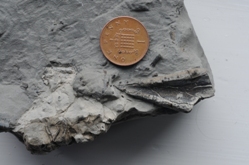
Responses from the consultation
We only received 32 responses. The consultation went to at least 130 individuals directly and was also widely circulated through newsletters and networks. There were also requests to forward the consultation through societies, associations, networks and every university department in the UK with an earth science faculty.
Images above and below: Close up views of parts of an as yet unidentified fish, possibly a condrostian, found by three different collectors from the Spittles landslide in the autumn of 2011. No one has seen anything like it from the Lower Jurassic in this area. Despite the local collecting effort, several blocks have probably been lost to the sea or possibly remain to be washed out of the landslide.
The response was disappointingly small but 28 of the respondents were either completely supportive of the Code or supportive with comments for improvement. The operation of certain elements the code, notably the quality of the records, attracted considerable criticism. The remaining four respondents expressed more serious concerns and made a number of suggestions for the modification of the Code and the overall management approach. Considerable parts of three of these four responses used identical wording.
We believe that it would be reasonable to assume that the vast majority of people consulted but who did not respond do not hold concerns about the Code or the condition of the West Dorset coast for the simple reason that if they did, they would be more motivated to respond.
The consultation centred around seven basic questions about our approach, site condition, barriers to acquisition, alternative approaches and the accessibility of the information about what is being found. It would be impossible to attempt to summarise the full range of responses and our consideration of them but that has been done and is available on the
Jurassic Coast web site.
The key issue regarding the best management approach for the West Dorset coast is that this is a rapidly eroding coastline with a rich store of fossils that are quite clearly at risk of destruction from the very processes that expose them. Over the last 200 years collectors, both amateur and professional, have demonstrated their value by rescuing specimens that now reside within accredited museum collections and that ‘tradition’ continues today. There is no way to effectively police the beaches or provide the required collecting effort that is so evidently needed; despite high collecting effort the fossils of most importance are rescued ‘just in the nick of time’ as they can only be found once they start to be uncovered by erosion.
The main criticism of the code is a suggestion that it lies outside ‘international thinking’ on best practice in geoconservation. The Code was endorsed by UNESCO as part of the Management Plan for the original nomination and inscription of the Jurassic Coast as a World Heritage Site in 2001. The Jurassic Coast Management Plan has subsequently been revised in 2010 and again endorsed by the UK Government and UNESCO as an effective way of managing this type of site which includes the management of fossil collecting. Some of the concern centres around ‘loss’ and here we draw attention to the Convention Concerning the Protection of the World Cultural and Natural Heritage (UNESCO) that includes: ‘Considering that deterioration or disappearance of any item of the cultural or natural heritage constitutes a harmful impoverishment of the heritage of all the nations of the world,…..’. The priority on our coast must be to protect the fossils from deterioration or disappearance (total loss) to the sea. Collectors, with open access to the coast are, and always have been, the mechanism that best achieves that. The full response also considers the Council of Europe recommendations on the conservation of geological heritage and recent, supportive guidance published by European ProGEO which is recognising that sites vary in their sensitivity to collecting.